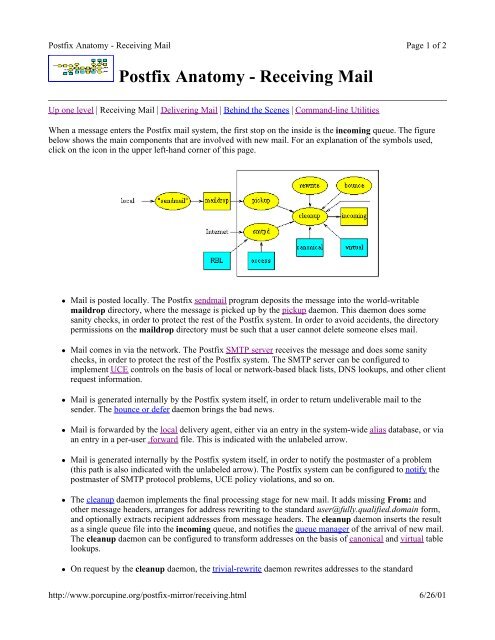Postfix Overview - Introduction - SCN Research
Postfix Overview - Introduction - SCN Research
Postfix Overview - Introduction - SCN Research
Create successful ePaper yourself
Turn your PDF publications into a flip-book with our unique Google optimized e-Paper software.
<strong>Postfix</strong> Anatomy - Receiving Mail<br />
Page 1 of 2<br />
<strong>Postfix</strong> Anatomy - Receiving Mail<br />
Up one level | Receiving Mail | Delivering Mail | Behind the Scenes | Command-line Utilities<br />
When a message enters the <strong>Postfix</strong> mail system, the first stop on the inside is the incoming queue. The figure<br />
below shows the main components that are involved with new mail. For an explanation of the symbols used,<br />
click on the icon in the upper left-hand corner of this page.<br />
• Mail is posted locally. The <strong>Postfix</strong> sendmail program deposits the message into the world-writable<br />
maildrop directory, where the message is picked up by the pickup daemon. This daemon does some<br />
sanity checks, in order to protect the rest of the <strong>Postfix</strong> system. In order to avoid accidents, the directory<br />
permissions on the maildrop directory must be such that a user cannot delete someone elses mail.<br />
• Mail comes in via the network. The <strong>Postfix</strong> SMTP server receives the message and does some sanity<br />
checks, in order to protect the rest of the <strong>Postfix</strong> system. The SMTP server can be configured to<br />
implement UCE controls on the basis of local or network-based black lists, DNS lookups, and other client<br />
request information.<br />
• Mail is generated internally by the <strong>Postfix</strong> system itself, in order to return undeliverable mail to the<br />
sender. The bounce or defer daemon brings the bad news.<br />
• Mail is forwarded by the local delivery agent, either via an entry in the system-wide alias database, or via<br />
an entry in a per-user .forward file. This is indicated with the unlabeled arrow.<br />
• Mail is generated internally by the <strong>Postfix</strong> system itself, in order to notify the postmaster of a problem<br />
(this path is also indicated with the unlabeled arrow). The <strong>Postfix</strong> system can be configured to notify the<br />
postmaster of SMTP protocol problems, UCE policy violations, and so on.<br />
• The cleanup daemon implements the final processing stage for new mail. It adds missing From: and<br />
other message headers, arranges for address rewriting to the standard user@fully.qualified.domain form,<br />
and optionally extracts recipient addresses from message headers. The cleanup daemon inserts the result<br />
as a single queue file into the incoming queue, and notifies the queue manager of the arrival of new mail.<br />
The cleanup daemon can be configured to transform addresses on the basis of canonical and virtual table<br />
lookups.<br />
• On request by the cleanup daemon, the trivial-rewrite daemon rewrites addresses to the standard<br />
http://www.porcupine.org/postfix-mirror/receiving.html<br />
6/26/01
















